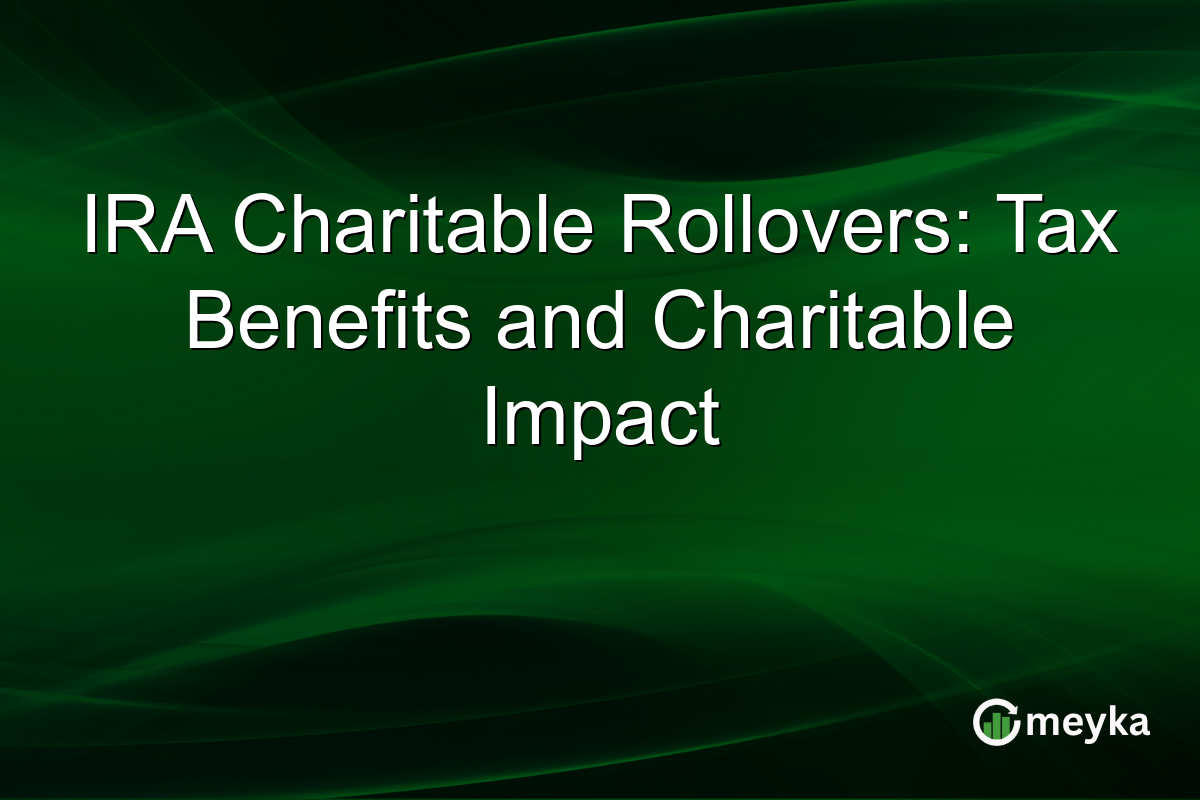IRA Charitable Rollovers: Tax Benefits and Charitable Impact
IRA charitable rollovers have emerged as a strategic tool for older investors looking to make tax-advantaged donations. By allowing individuals over 70½ to transfer funds directly from their IRAs to qualified charities, these rollovers help in reducing taxable income. Additionally, they can satisfy Required Minimum Distributions (RMDs), offering a dual benefit of fulfilling charitable intentions while optimizing tax situations. Understanding the mechanics and benefits of IRA charitable rollovers can significantly enhance financial planning strategies.
Understanding IRA Charitable Rollovers
IRA charitable rollovers, also known as Qualified Charitable Distributions (QCDs), allow individuals aged 70½ or older to directly donate up to $100,000 per year from their individual retirement accounts to charity. This direct transfer is excluded from taxable income, providing a tax-efficient way to meet philanthropic goals while potentially lowering tax liabilities. Moreover, these transfers count towards satisfying the Required Minimum Distributions (RMDs) that generally must begin at age 72.
An example highlights this advantage: consider an investor who wants to minimize taxable income while meeting RMD requirements. By using an IRA charitable rollover, they can achieve both, thereby aligning their financial strategy with their charitable objectives. IRA Charitable Rollover Discussion on Reddit.
The Tax Advantages of IRA Charitable Rollovers
The primary tax benefit of an IRA charitable rollover is the reduction in taxable income. Unlike regular IRA withdrawals, which are taxed as ordinary income, QCDs are not included in taxable income. This reduction effectively lowers Adjusted Gross Income (AGI), which can lead to beneficial side-effects such as lower Medicare premiums and improved tax thresholds.
Reducing AGI can be especially advantageous for retirees who face increased taxation from Social Security income or higher capital gains taxes. By leveraging IRA charitable rollovers, donors maintain their standard of living while financially supporting their preferred charities. This reduced tax exposure maximizes the impact of philanthropic contributions without affecting tax bracket positioning.
Charitable Impact and Compliance
Beyond personal tax benefits, IRA charitable rollovers significantly benefit charitable organizations. Direct rollovers ensure that funds reach charities without the tax deductions typically associated with individual donations. This method guarantees that donations are received in full and can be used efficiently by nonprofits.
For compliance, it’s essential the funds are transferred directly from the IRA to the charity. If individuals handle the funds first, the tax advantages are nullified. Careful planning and coordination with financial advisors ensure proper execution and compliance, rewarding donors with clear financial benefits.
Final Thoughts
In conclusion, IRA charitable rollovers serve as a powerful tool for taxpayers over 70½, allowing them to fulfill charitable ambitions while enjoying substantial tax benefits. By reducing taxable income and satisfying RMD requirements with direct transfers to charities, individuals optimize their financial and philanthropic outcomes. As more retirees become aware of these advantages, IRA charitable rollovers are likely to become a staple in charitable and financial planning strategies. Engaging with a financial advisor ensures that the process is compliant and beneficial, maximizing both tax advantages and charitable impacts.
FAQs
An IRA charitable rollover, or Qualified Charitable Distribution (QCD), allows individuals aged 70½ or older to transfer up to $100,000 directly from an IRA to a charity. This transfer is excluded from taxable income and counts towards Required Minimum Distributions (RMDs).
By excluding the rollover amount from taxable income, it lowers the Adjusted Gross Income (AGI). This can lead to reduced taxes, lower Medicare premiums, and decreased chances of triggering additional taxes on Social Security income.
To execute a rollover, ensure the funds are transferred directly from the IRA to the charity. Working with a financial advisor and coordinating with the IRA custodian helps in handling the process correctly, ensuring compliance and tax benefits.
Most public charities can receive rollovers, but some organizations, like donor-advised funds and private foundations, are excluded. It’s crucial to verify the charity’s eligibility before initiating a rollover to ensure compliance and maximize benefits.
They are particularly beneficial for those who do not itemize deductions, as they reduce taxable income regardless of standard or itemized deductions. However, individual financial circumstances vary, so consulting with a financial advisor is recommended.
Disclaimer:
This is for information only, not financial advice. Always do your research.






